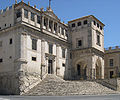Palma di Montechiaro
| Palma di Montechiaro | ||
|---|---|---|

|
|
|
| Country | Italy | |
| region | Sicily | |
| Free community consortium | Agrigento (AG) | |
| Local name | Parma (di Muntichiaru) | |
| Coordinates | 37 ° 12 ' N , 13 ° 46' E | |
| height | 165 m slm | |
| surface | 76.36 km² | |
| Residents | 22,262 (Dec. 31, 2019) | |
| Population density | 292 inhabitants / km² | |
| Post Code | 92020 | |
| prefix | 0922 | |
| ISTAT number | 084027 | |
| Popular name | Parmisi | |
| Patron saint | Madonna del Castello | |
Palma di Montechiaro is a town in the municipality of Agrigento consortium outdoors in the region Sicily in Italy .
Location and dates
Palma di Montechiaro is located 27 kilometers southeast of Agrigento near the coast. The 22,262 inhabitants (as of December 31, 2019) work mainly in agriculture, cattle breeding, in the furniture industry and in food production.
The neighboring municipalities are Agrigento, Camastra , Licata and Naro .
history
The city was founded in 1638 by Prince Carlo Tomasi di Lampedusa under the name Palma. In 1861 it was given the name of the nearby Montechiaro Castle as an additional nickname.
Buildings
In the town
The main sights in town were built by order of the princes of Lampedusa. The main church of Santa Maria del Rosario, also called Chiesa Madre , was built in 1666 in the style of the Sicilian Baroque . The Benedictine monastery Maria del Rosario and the Palazzo Ducale also date from the 17th century.
In the neighborhood
The Castello Montechiaro is located about two kilometers southeast of the city on a hill and was built in the 14th century by the Chiaramonte family to protect against pirates. In the district of Marina di Palma, five kilometers south of the city on the beach of the Palmesi, there is the Torre di San Carlo, a watchtower from the 17th century. Finds from prehistoric times were discovered in the Zubia grotto . On Monte Grande, around six kilometers west of the city, remains of a settlement from the early Sicilian Bronze Age have been excavated at various points . The finds are to be assigned to the Castelluccio culture ; There were also fragments of vessels from the eastern Mediterranean, especially Middle Helladic and early Late Helladic ceramics from Greece, which testify to extensive trade.
additional
Giuseppe Tomasi di Lampedusa , one of the descendants of the city's founder Carlo Tomasi di Lampedusa, described Palma di Montechiaro and its surroundings in his novel Il Gattopardo . Several scenes of the film of the same name (German title: The Leopard ) directed by Luchino Visconti were shot here.
Web links
- Palma di Montechiaro information (Italian)
Individual evidence
- ↑ Statistiche demografiche ISTAT. Monthly population statistics of the Istituto Nazionale di Statistica , as of December 31 of 2019.






